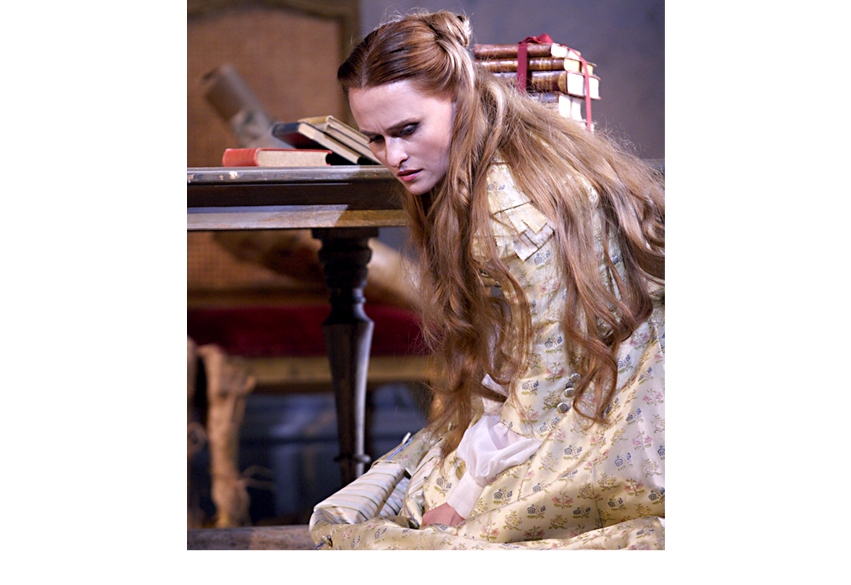Whereas Don Giovanni seems, for assorted reasons, to be unfloatable at present, The Marriage of Figaro is virtually unsinkable, with Così somewhere between. In general it seems that comedies go in and out of favour and fashion more than tragedies or ‘straight’ works, though Figaro may be a glorious exception, like Die Meistersinger. It is horrible to contemplate the possibility of a world which was indifferent to their charms and profundities.
Even so, the new production of Figaro at ENO gives some cause for alarm. Fiona Shaw, who has not previously produced a classic opera, sees the work as a maze, a harmless enough notion unless you take it that in the middle of a maze there must be a Minotaur, the only candidate for that in Figaro being the Count. Someone should point Shaw to Idomeneo; she seems to have them confused.
Peter McKintosh has obliged with a set, or sets, which consist of white walls with rectangular door-sized holes in them, even an occasional door where necessary, and flights of steps. For the first two acts it revolves giddily, for the second two it is a bit calmer, but still fidgety. It creates no particular atmosphere. Clothes are 18th-century to start with — Shaw is intent on that touch, because of the droit de seigneur motif — but become more modern later, presumably a postmodernist feature to get us to realise the timelessness of the action; as, too, are the vacuum cleaner and Cherubino’s video camera.
There are lots of bull’s heads around to enforce the central conceit, and in Act IV we get the centre of the maze, I think; but I was distracted by the Count’s being in his underpants throughout that act: surely it’s taking his lechery a bit far to have him so well prepared for sex? — and his duet with Susanna in Act III had given him an erection he had some difficulty handling. Oh, just before Barbarina sings her heartbroken arietta about the lost pin at the beginning of Act IV, she throws up, having inherited her father Antonio’s alcoholism.
To enhance a sense of crisis and muddle, there are many non-singing extras who run, stride or creep through the holes and along the walls incessantly; we visit the shoe-cleaning room, and the kitchen where a hog is being roasted. But none of this is intended to distract us from the point of the work, which, according to Shaw, is that we are all sinners, no one is worse than anyone else. Not only is that nonsense in the real world, it is just as much nonsense in Figaro. Perhaps Roland Wood’s bland, characterless acting and singing of the Count is meant to enforce the point, but it removes all the menace and sexual tension from the opera.
The cast is nearly uniformly mediocre, the exception being the Countess of Elizabeth Llewellyn, a last-minute replacement for the indisposed Kate Valentine. Llewellyn refused to be put off by the St Vitus’s Dance of the production, and gave a performance of great poise and dignity. Iain Paterson is Figaro, but was on far from his best form. Paul Daniel’s conducting must take a share of the blame: co-ordination with the stage was poor, though it must have been difficult as the singers had to run on the spot to stay where they were. But anyone who introduces such immense pauses in the Count’s plea for forgiveness and the Countess’s response is no Mozartian; that kind of hamming is more suitable for Richard Strauss.
Any new production of Figaro is a matter of concern for the regular opera-goer, because it will be coming back quite often, and it is important to know how satisfactory it will be. With stronger casting, and a let-up in the fairground scenery, this could become an enjoyable if not outstanding show. With all its annoyances and missed chances for laughter and pathos, I still found it a worthwhile evening — just.
Which is far more than I can say for the newest revival of La traviata at the Royal Opera; 15 performances before Christmas, more after. Why, apart from the obvious answer, which I wouldn’t discredit the Royal Opera by suggesting? The first cast is wretched, with Marina Poplavskaya both acting vulgarly and making Violetta a vulgar character. She staggers around the stage in Act I, crouches beside, almost beneath a large table in Act II — but so would I with Leo Nucci, Germont père, bellowing at me; and fails at any point to live in the character or to sing words, as opposed to sounds, many of them off-pitch.
I have seen this tolerable production many times, but it has never served a cast which seemed to have so little belief in Verdi’s drama, or so little idea of how to bring its characters to life.






Comments